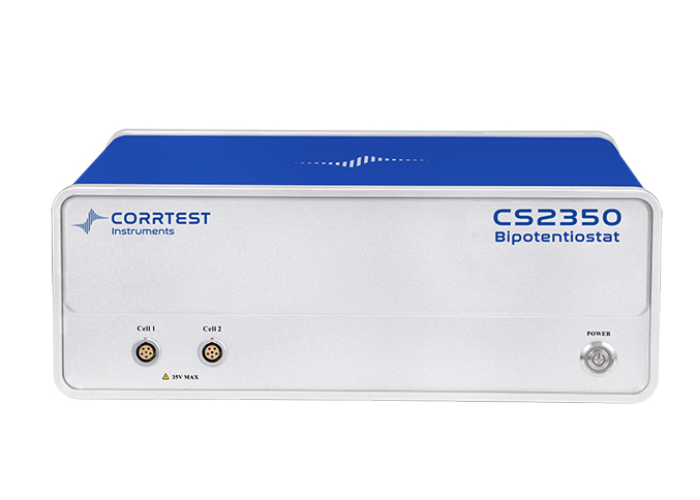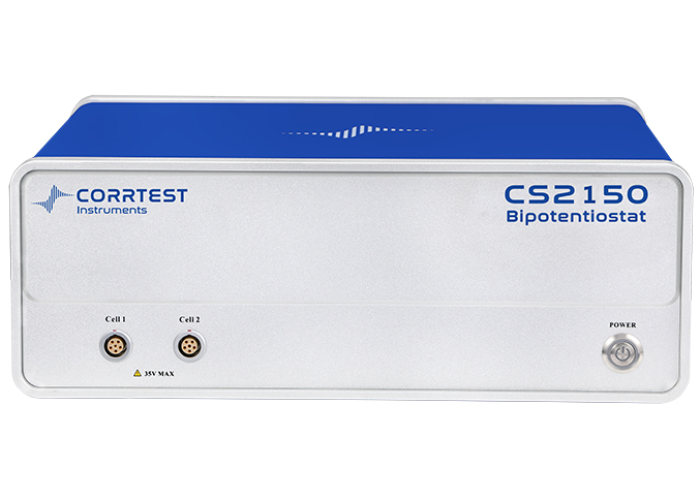Bipotentiostat

CS2350M Bipotentiostat (2-channel, with EIS)
- Support 2-, 3- or 4-electrode system: Interface: Ethernet
- Potential control range: Primary Channel: ±10V second Channel: ±10V: Current control range: ±1A for each channel
- Potential control accuracy: 0.1%×full range±1mV: Current control accuracy: 0.1%×full range
- Potential resolution: 10μV (>100Hz), 3μV (<10Hz): Current sensitivity:1pA

CS2150M Bipotentiostat (2-channel, No EIS)
- Support 2-, 3- or 4-electrode system: Interface: Ethernet
- Potential control range: Primary Channel: ±10V second Channel: ±10V: Current control range: ±1A for each channel
What is a Bipotentiostat?
A bipotentiostat is a specialized type of potentiostat designed to control and monitor two working electrodes simultaneously within the same electrochemical cell, alongside a single reference electrode and a single counter (auxiliary) electrode. The main distinction from a standard (monopotentiostat) system is the presence of two independently controlled working electrodes rather than just one.
Key Components and Operation
- Reference Electrode: Maintains a constant potential and serves as the reference point for both working electrodes.
- Counter (Auxiliary) Electrode: Completes the electrical circuit, allowing current to flow.
- Two Working Electrodes: Each can be operated at its potential, either independently or with a defined potential offset between them. This enables simultaneous monitoring and control of separate electrochemical reactions or processes.
How It Works
- The bipotentiostat can apply different potentials to each working electrode, allowing for the study of coupled electrochemical reactions or the detection of reaction intermediates.
- Working electrode 2 can either hold a constant potential or track the potential of working electrode 1 with a programmable offset, maintaining a constant potential difference between the two.
- Currents at both electrodes are measured independently, providing detailed insight into complex electrochemical mechanisms.
Common Applications
- Rotating Ring-Disk Electrode (RRDE) Experiments: Used to generate and detect reaction intermediates; the disk and ring electrodes are independently controlled to study reaction pathways and kinetics.
- Electrochemical scanning microscopy (SECM): Identifies surface polarization and electrochemical activity maps.
- Sensor Development: Enables simultaneous measurement from two sensors or comparison between a sensor and a blank.
- Transistor Gate Control: Used in ISFET (Ion-Sensitive Field Effect Transistor) studies.
Electrochemical Techniques Supported
Typical techniques performed with a bipotentiostat include:
- Linear Sweep Voltammetry (LSV)
- Cyclic Voltammetry (CV)
- Chronoamperometry (CA)
- Chronocoulometry (CC)
- Multistep Amperometry (MA)
| Feature | Monopotentiostat | Bipotentiostat |
|---|---|---|
| Working Electrodes | 1 | 2 |
| Reference Electrodes | 1 | 1 |
| Counter Electrodes | 1 | 1 |
| Control | Single WE | Both WEs independently |
| Typical Applications | General electrochemistry | RRDE, SECM, dual sensing |
A bipotentiostat is essential for advanced electrochemical experiments requiring the simultaneous control and measurement of two working electrodes, offering greater flexibility and insight into multi-step or coupled reaction systems.
Overview: Bipotentiostat Comparison
This report summarizes the key features and differences between the CS2350M Bipotentiostat (with EIS) and the CS2150M Bipotentiostat (without EIS), both designed for advanced electrochemical experiments.
CS2350M Bipotentiostat (2-Channel, with EIS)
- Channels: 2 independent potentiostat/galvanostat channels, each with built-in EIS (Electrochemical Impedance Spectroscopy)
- Electrode Systems Supported: 2-, 3-, or 4-electrode configurations
- Interface: Ethernet connection
- Potential Control Range: ±10 V on each channel
- Current Control Range: ±1 A for each channel
- Potential Control Accuracy: 0.1% × full range ±1 mV
- Current Control Accuracy: 0.1% × full range
- It is accurate within 0.1% for the full range and 1 mV at all potentials
- Current Sensitivity: 1 pA
- Applications: Suitable for RRDE, hydrogen diffusion tests, electrosynthesis, battery research, corrosion studies, and more
- Special Features:
- Both channels can run experiments independently or jointly (e.g., RRDE, HDT)
- Full suite of electrochemical techniques, including EIS on both channels
- Real-time data saving, even during power loss
- 5-year warranty and lifetime free software upgrades
CS2150M Bipotentiostat (2-Channel, No EIS)
- Channels: 2 independent potentiostat/galvanostat channels, no EIS module
- Electrode Systems Supported: 2-, 3-, or 4-electrode configurations
- Interface: Ethernet connection
- Potential Control Range: ±10 V on each channel
- Current Control Range: ±1 A for each channel
- It is accurate within 0.1% for full range and 1 mV at all potentials
- Current Control Accuracy: 0.1% × full range
- Potential Resolution: 10 μV (>100 Hz), 3 μV (<10 Hz)
- Current Sensitivity: 1 pA
- Applications: Similar to CS2350M but without impedance spectroscopy; ideal for dual independent cell testing, RRDE, HDT, corrosion, battery, and materials research
- Special Features:
- True independent operation for each channel
- Can connect to two independent cells simultaneously
- Cost-effective solution for users who do not require EIS
| Feature | CS2350M (with EIS) | CS2150M (No EIS) |
|---|---|---|
| Channels | 2 (independent, with EIS) | 2 (independent, no EIS) |
| EIS Capability | Yes (both channels) | No |
| Electrode Systems | 2-, 3-, 4-electrode | 2-, 3-, 4-electrode |
| Interface | Ethernet | Ethernet |
| Potential Control Range | ±10 V | ±10 V |
| Current Control Range | ±1 A | ±1 A |
| Potential Accuracy | 0.1% × range ±1 mV | 0.1% × range ±1 mV |
| Current Accuracy | 0.1% × range | 0.1% × range |
| Potential Resolution | 10 μV (>100 Hz), 3 μV (<10 Hz) | 10 μV (>100 Hz), 3 μV (<10 Hz) |
| Current Sensitivity | 1 pA | 1 pA |
| Typical Applications | EIS, RRDE, HDT, batteries, corrosion | RRDE, HDT, batteries, corrosion |
| Software/Support | Lifetime upgrades, 5-year warranty | Lifetime upgrades, 5-year warranty |
Summary
ScienceGears offers two advanced bipotentiostat models for electrochemical research: the CS2350M Bipotentiostat (2-channel, with EIS) and the CS2150M Bipotentiostat (2-channel, No EIS).
CS2350M is best suited for advanced electrochemical research requiring impedance spectroscopy (EIS) on both channels, with the flexibility to run simultaneous or combined experiments. CS2150M offers similar core electrochemical capabilities but omits EIS, making it a cost-effective choice for users who do not require impedance analysis. Both models provide robust, independent dual-channel operation, high sensitivity, and broad application support in electrochemistry.
